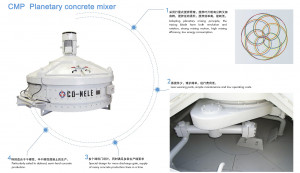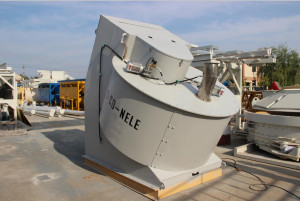Most of the raw materials of refractory materials belong to non-plastic bismuth materials, and it is difficult to process them into semi-finished products by themselves. Therefore, it is necessary to use an external organic binder or an inorganic binder or a mixed binder. The various special refractory raw materials are subjected to strict and accurate batching to make a mud material with uniform particle distribution, uniform water distribution, certain plasticity and easy forming and semi-finished products. It is necessary to adopt a production process with high efficiency, good mixing effect and suitable mixing.
(1) Particle matching
The billet (mud) can be made into a product with the highest bulk density by selecting a reasonable particle composition. Theoretically, a single-size sphere of different inches and different materials was tested, and the bulk density was virtually the same. In any case, the porosity was 38% ± 1%. Therefore, for a single-size ball, its bulk density and porosity are independent of the size of the ball and the material properties, and are always stacked in a hexagonal shape with a coordination number of 8.
The theoretical stacking method of a single particle of the same size has a cube, a single oblique column, a composite oblique column, a pyramidal shape, and a tetrahedron. The various stacking methods of the same size sphere are shown in Fig. 24. The relationship between the deposition method of single particles and the porosity is shown in Table 2-26.
In order to increase the bulk density of the material and reduce the porosity, a sphere of unequal particle size is used, that is, a certain number of small spheres are added to the large sphere to increase the composition of the sphere, and the relationship between the volume occupied by the sphere and the porosity is shown in the table. 2-27.
With the clinker ingredients, the coarse particles are 4. 5 mm, the intermediate particles are 0.7 mm, the fine particles are 0.09 mm, and the change of the clinker porosity of the clinker is shown in Figure 2-5.
From Figure 2-5, the coarse particles are 55% ~ 65%, the medium particles are 10% ~ 30%, and the fine powder is 15% ~ 30%. The apparent porosity can be reduced to 15.5%. Of course, the ingredients of special refractory materials can be appropriately adjusted according to the physical properties and particle shape of the materials.
(2) Bonding agent for special refractory products
Depending on the type of special refractory material and the molding method, the binders that can be used are:
(1) Grouting method, gum arabic, polyvinyl butyral, hydrazine methyl cellulose, sodium acrylate, sodium alginate, and the like.
(2) The squeezing method, including the lubricants, glycols,
Polyvinyl alcohol, methyl cellulose, starch, dextrin, maltose and glycerin.
(3) Hot wax injection method, the binders are: paraffin wax, beeswax, lubricants: oleic acid, glycerin, stearic acid and the like.
(4) Casting method, bonding agent: methyl cellulose, ethyl cellulose, cellulose acetate, polyvinyl butyral, polyvinyl alcohol, acrylic; plasticizer: polyethylene glycol, dioctane Phosphoric acid, dibutyl peroxide, etc.; dispersing agent: glycerin, oleic acid; solvent: ethanol, acetone, toluene, and the like.
(5) Injection method, thermoplastic resin polyethylene, polystyrene, polypropylene, acetyl cellulose, propylene resin, etc., may also heat hard phenolic resin; lubricant: stearic acid.
(6) Isostatic pressing method, polyvinyl alcohol, methyl cellulose, using sulfite pulp waste liquid, phosphate and other inorganic salts when forming pellets.
(7) Press method, methyl cellulose, dextrin, polyvinyl alcohol, sulfite pulp waste liquid, syrup or various inorganic salts; sulfite pulp waste liquid, methyl cellulose, gum arabic , dextrin or inorganic and inorganic acid salts, such as phosphoric acid or phosphates.
(3) Admixtures for special refractory products
In order to improve certain properties of specialty refractory products, control the crystal form conversion of the article, reduce the firing temperature of the article, and add a small amount of admixture to the furnish. These admixtures are mainly metal oxides, non-metal oxides, rare earth metal oxides, fluorides, borides and phosphates. For example, adding 1% ~ 3% boric acid (H2BO3) to γ-Al2O3 can promote the conversion. The addition of 1% to 2% TiO2 to Al2O3 can greatly reduce the firing temperature (about 1600 ° C). The addition of TiO2, Al2O3, ZiO2, and V2O5 to MgO promotes the growth of the cristobalite grains and lowers the firing temperature of the product. Addition of CaO, MgO, Y2O3 and other additives to the ZrO2 raw material can be made into a cubic zirconia solid solution which is stable from room temperature to 2000 °C after high temperature treatment.
(4) Method and equipment for mixing
Dry mixing method
The inclined strong countercurrent mixer produced by Shandong Konyle has a volume of 0.05 ~ 30m3, suitable for mixing various powders, granules, flakes and low-viscosity materials, and is equipped with a liquid adding and spraying device.
2. Wet mixing method
In the conventional wet mixing method, the ingredients of various raw materials are placed in a planetary mixer equipped with a protective liner for fine grinding. After the slurry is made, a plasticizer and other admixtures are added to adjust the mud density, and the mixture is thoroughly mixed in a vertical shaft planetary mud mixer, and granulated and dried in a spray granulation dryer.
Planetary mixer
3. Plastic compounding method
In order to produce a highly versatile compounding method for a special refractory product blank suitable for plastic forming or sludge forming. In this method, various raw materials, admixtures, plasticizers, and lubricants and water are thoroughly mixed on a planetary mixer, and then mixed and mixed on a high-efficiency intensive mixer to remove bubbles in the mud. In order to improve the plasticity of the mud, the mud is mixed with the stale material, and the mud is subjected to the second mixing on the clay machine before molding. Koneile produces high-efficiency and powerful mixers as shown below:
Efficient and powerful mixer
Countercurrent mixer
4. Semi-dry mixing method
Suitable for mixing methods with lower moisture. The use of semi-dry mixing method is required for the special refractory products which are machine-formed by granular ingredients (coarse, medium and fine three-stage ingredients). The ingredients are carried out in a sand mixer, a wet mill, a planetary mixer or a forced mixer.
The mixing procedure is to first dry mix the various grades of granules, add the aqueous solution containing the binder (inorganic or organic), and add the mixed fine powder (including the combustion aid, expansion agent, and other additives). The agent) is thoroughly mixed. The general mixing time is 20 ~ 30min. The mixed mud should prevent particle size segregation and the water should be evenly distributed. If necessary, the mud material should be properly trapped during molding.
The moisture content of the press-formed product mud is controlled at 2.5% to 4%; the moisture content of the mud-shaped molded product is controlled at 4.5% to 6.5%; and the moisture content of the vibrating molded product is controlled at 6% to 8%.
(1) Technical performance of the CMP series of energy efficient planetary mixers produced by Kone.
(2) Technical performance of wet sand mixer
5. Mud mixing method
The mud mixing method is for the production of special refractory ceramic products, especially the mud slurry for gypsum injection molding, casting molding and injection molding. The method of operation is to mix various raw materials, reinforcing agents, suspending agents, admixtures and 30% to 40% of clean water into a ball mill (mixing mill) with wear-resistant lining, and mix and grind after a certain period of time. , made into a mud slurry for molding. In the process of making mud, it is necessary to control the density and pH of the mud according to the material characteristics and the requirements of the mud casting itself.
Countercurrent powerful mixer
The main equipment used in the mud mixing method is a ball mill, an air compressor, a wet iron removal, a mud pump, a vacuum deaerator, and the like.
6. Heating mixing method
Paraffin and resin-based binders are solid substances (or viscous) at normal temperature, and cannot be mixed at room temperature, and must be heated and mixed.
Paraffin is used as a binder when using the hot die casting process. Because the melting point of paraffin wax is 60~80 °C, the paraffin wax is heated to above 100 °C in the mixing and has good fluidity. Then the fine powder raw material is added to the liquid paraffin, and after fully mixing and mixing, the material is prepared. The wax cake is formed by hot die casting.
The main mixing equipment for heating the mixture is a heated agitator.
Post time: Oct-20-2018


